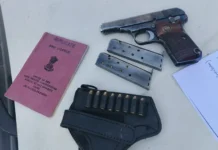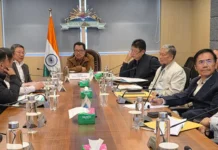[ Langto Wangpan ]
The hardworking and peace-loving Wanchos inhabit Longding district of Arunachal Pradesh. They live in their own independent way by emulating their own ethos, traditional heritage, cultural identity and ethical treasures of immense value. Jhum cultivation or shifting cultivation is the mainstay of the people, apart from other economic activities. Chieftaincy, with the Wangham as the head, still prevails in every Wancho village. The village council is called Ngo-Wang. It is empowered with all political and judicial responsibilities within the village and the Wancho society. Wanchos believe in the existence of an almighty, omnipotent, omnipresent and omniscient god whom they call Jowaan Zang. Jowaan Zang means the god in the sky. Jowaan is not the name of the god; jowaan means simply ‘god’. The people live their life following and keeping the sanctity of the Waanlam, ie, the code of living as given by god. The people are believers of Jowaan and followers of the Waanlam, which we can call indigenous faith or way of worship.
It is believed that one group of the Wanchos migrated through Tangnu and the other through the Sangnu. In those days, there used to be inter-village feuds for various reasons. Some anthropologists term it headhunting, which needs to be re-looked. In fact, the inter-village feuds were an offensive policy of those people in order to expand their territory, gain supremacy over the neighbouring villages, as well as to defend and protect themselves.
Wanchos celebrate a number of fairs and festivals, such as Oriah, Lauden, Sahchawan, Pungzm, etc. All these festivals differ in the time of celebration, type of rituals performed and place or location of the celebration. But people being agrarian, most of these festivals are related to the agricultural processes and Mother Nature. Rituals are an integral part of every celebration. Celebration cannot be without performing a ritual. The almighty god Jowan Zang is invoked by uttering its name while offering rice beer. The act of performing this ritual is called Ju-O.
Oriah is the most prominently and enthusiastically celebrated annual festival throughout the Wancho area, though other festivals are not at all less important or less cherished. Usually, Oriah is celebrated at the beginning of the spring season. It lasts for the whole season in the Wancho area because it is celebrated on different dates in different villages, as per the decision of the respective village Ngo-Wang. The date is announced by the respective village Ngo-Wang according to the lunar calendar they maintain. Generally it is celebrated in the first half of the lunar month.
In the process of practicing jhum cultivation, the village selects a particular area of their jhum field by performing a ritual called Ozok-Nantak during the Lauden festival, which is generally celebrated in the month of August-September (Wancho month Ngan). The people cut the forest, burn it and clear the jhum plot by the month of January-February (Wancho month Tchang). When the plot is ready, millet is sown ceremonially. A small hut, which is called taap, is built in the field. During all these work, the people have no time to rest. After toiling hard for completion of these works, they get time for leisure and merrymaking. This period is meant for the Oriah. The deep meaning of Oriah is prayer and celebration. ‘O’ stands for the sacred offering to the Jowaan for bumper crop and prosperity and ‘Riah’ stands for the leisure and celebration. So Oriah means prayer and celebration.
The most important feature of Oriah festival is the procurement and installation of a sacred bamboo called zangwaan, with seven branches. These seven branches stand for the seven main crops of the Wanchos. They are: hikha (millet), tchah (paddy), ‘to’ (colocasia), zaampa/sowing (maize), pankhan (tapioca), ophom (a kind of leafy vegetable), nam (till), tula (yeast millet), and nyepho-phiasa (pulses).
Zangwaan is the central feature of Oriah festival. In the village, the zangwaan is procured, decorated and installed at the sacred platform called zangwaantong, near the village’s sacred grove called sautong, which generally is in front of the village chief. This duty is performed by the traditionally appointed and assigned youths of Paanu and Paasa.
Zangwaan is the symbol of Oriah festival. It is also the symbol of Wancho culture and Wancho Wanlam. We offer our prayers for rich harvest in the agricultural fields, good health and prosperity of the people and wellbeing of the people. Wanchos worship nature since time immemorial. Homni genesis like land, water, forests and animal species are equally considered in our culture. Destruction of nature is considered destruction of human life itself. Protection of environment and maintaining ecological balance is a prime concern of the people. So the zangwaan is installed after purification as a symbol of nature. Only a specified variety of bamboo species called Zo is used in the construction of the zangwantong. Zo is the species which is of multi-utility, unlike other bamboo varieties.
On the arrival of the spring season, every Wancho prepares and waits for Oriah. Menfolk sing “Zangwaanngoihai… ku ae ponglang-laahuak le taan tai aa…,” which means, “O Zangwaan, I am waiting for your arrival with sacrificed cattle and pigs.” When the zangwaan is procured and decorated, it is purified by offering rice beer (ju-o). We chant “Zangwaannu… posheylohleyngoihai o…,” which means, “Zangwaannu, come with abundant flowers and fruits.” With the passage of time, we have done away with the practice of sacrificing live animals to purify the sacred Zangwaan. We perform the ju-o, where the purest form of rice beer is offered. We chant “Zangwaannu… hanpohanjiaksaaitohpha o,” which means. “O Zangwannu, sow your flowers and fruits in the form of rich harvest and prosperity.”
Once the date is announced, the preparation for Oriah starts in full swing. On an appointed day, the zangwaan is installed and Oriah starts with the sacrifice of cattle and pigs for feast. The womenfolk prepare sticky rice (zaam) and sticky millet (hinai) in bamboo tubes for offering to Zangwaan and also for consumption. It is called sahphat. The Bonu Nyih and Bosa Nyih are the main days for the performance of dance at the Zangwaantong. It is a time of great rejoicing among the people. Relatives and friends exchange meat, drinks and gifts. Feasting, singing and dancing have no limit.
Oriah is celebrated by the Wanchos since time immemorial in their respective villages. But it was in 1975 that the first common Oriah was celebrated at Kanubari. From the next year onwards, Oriah was celebrated in Longding HQ. The date was later on fixed by the government of Arunachal Pradesh. Since then, the common Oriah is celebrated on 16 February every year.
In due course of time, the Wancho people residing in various administrative HQs within Longding district started celebtating Oriah at their respective HQs. Today, Oriah is celebrated at all the places where Wanchos are residing. Celebrating Oriah at different places aims to promote harmonious coexistence of the Wancho people, leaving aside the memories of the past feuds and differences. It is also an attempt to promote our rich tradition and showcase the colourful traditions which we inherited from the forefathers. Celebrating Oriah as one entity by the people of different villages at one place speaks volumes on the unity and harmony among them.
Today, in the name of modernization and due to misinterpretation of our traditional practices, a handful of people are inciting others to bring changes in the celebration of Oriah and other festivals, which will degrade and demean the essence of Oriah. We cannot sacrifice our Wancho culture and traditions at the altar of development, education, modernization and politics.
Culture is a dynamic and vibrant entity of any community. We have to march ahead in tune with the need of the time. This would certainly require some changes. But if we change the systems and do not continue our traditions, we will be people without an identity. If we don’t change, we won’t be able to catch up with the rest of the world. Therefore we have to accept and assimilate certain useful ideas from others and still be Wancho in all essentials.
It is high time that the Wancho youths came forward to take up the responsibility to sustain Oriah festival in its pristine form and promote Wancho culture. (The writer is the president of the Oriah Celebration Committee, Longding, 2022)



